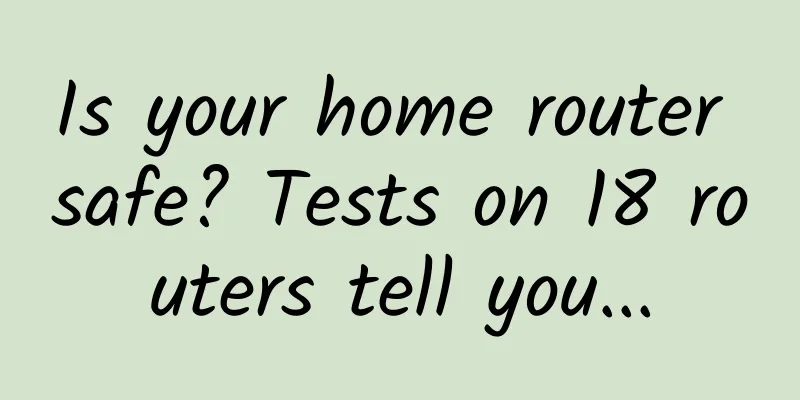Is your home router safe? Tests on 18 routers tell you...

|
Fearing Wi-Fi radiation, parents asked schools to stop using wireless routers; when his wife was pregnant, the husband went door to door asking neighbors to stop using Wi-Fi. Last year, a domestic company launched a router with a "pregnancy mode", claiming that it could "significantly reduce radiation"... Are these rumors true? Is router radiation really harmful to the human body? The routers were purchased randomly by the Sichuan Provincial Consumer Council and Yibin Municipal Consumer Council staff in the Chengdu and Yibin markets, and then sent to the Chongqing Metrology and Quality Inspection Institute for professional testing. A total of 18 groups of wireless routers were involved in the test, involving 8 brands, with different powers, covering the range used by ordinary households.
Electromagnetic radiation is "invisible" and cannot be seen or touched. To test it, the wireless router must be placed in a specific space.
Test process: measuring router radiation in a closed darkroom This 9-meter-long, 6-meter-wide, and 6-meter-high enclosed space is called a "microwave darkroom" and has no windows but only a small door. The walls of the darkroom are made of protruding gray-white square materials. "This is imported absorbing material that can absorb electromagnetic waves projected onto its surface," said engineer Li Peipei. In the middle of the darkroom is a turntable with a broadband log-periodic hybrid antenna installed on it, which can scan the router on the table in the middle of the turntable in both horizontal and vertical directions to receive the electromagnetic radiation it emits. Not far from the darkroom is the control room, where engineers use EMI receivers to detect the electromagnetic radiation emitted by the router to the antenna.
Test results show that the radiation of the "wall-penetrating king" router exceeds the standard First of all, we need to understand the safe radiation value that the human body can withstand. my country's current electromagnetic radiation protection standard is the national standard "GB8702-88", which stipulates the public exposure limit. The electromagnetic radiation of electronic products such as wireless routers is safe if it is below 40 decibels (microvolts per meter). In this test, among the 18 groups of routers tested, the actual measured values of the "ZTE" intelligent wall-penetrating 300M wireless router E5501S model produced by ZTE Corporation were: when the test frequency was 193.337 MHz, the quasi-peak value was 49.0 decibels (microvolts per meter); when the test frequency was 209.942 MHz, the quasi-peak value was 41.7 decibels (microvolts per meter); when the test frequency was 193.363 MHz, the quasi-peak value was 45.3 decibels (microvolts per meter). In all three groups of tests, the limit of 40 decibels (microvolts per meter) in the national standard was exceeded. In other words, the radiation from this wireless router called "Smart Wall-Penetration King" exceeds the standard. Other tests/router heating test, all are normal According to the relevant requirements of national standards, the allowable temperature of the host casing is 95°C, the allowable temperature of the power adapter casing is 95°C, and the allowable temperature of the 9V power cord is 75°C. The indentation diameter of thermoplastic plastic parts directly installed with dangerous voltage components, that is, the deformation of the power adapter plugged into the socket, cannot exceed 2.0 mm. According to the experimental results, the host casing temperature of these 18 groups of routers was between 43.6℃-55.1℃, the power adapter casing temperature was between 42.9℃-49.4℃, and the power cord temperature was between 35.6℃-40.9℃, all of which were within the normal range.
Router deformation test, two models failed to meet the standard In addition, the power adapter needs to be directly connected to a 220V power source during operation. Whether it deforms when heated is related to its safety. These deformations cannot be seen with the naked eye. After testing, the two groups of samples of "TOTO LINK" 300mbps (megabits per second) high-gain wireless router N350RP and dual-band wireless router N630R produced by Shenzhen Shengshi Zhongtang Technology Co., Ltd. had the actual measured values of the indentation diameter of the power adapters being 3.10 mm and 3.02 mm respectively, far exceeding the limit allowed by the national standard. Important Tips: Radiation is divided into two categories. One is ionizing radiation, such as alpha rays, X-rays and neutron rays. This type of radiation, like the X-ray examinations we do in hospitals and nuclear radiation, can easily cause cancer if the radiation is too much. The other type is non-ionizing radiation, such as visible light, ultraviolet rays, electromagnetic radiation, etc. The electromagnetic radiation of wireless routers is relatively small and generally does not cause direct harm to the human body. Compared with the test environment, we are not so close to the router in our daily life, and electromagnetic radiation will decay rapidly with the distance. At a distance of about 3 meters from the router, the test value is basically less than 1 decibel (microvolt per meter). At this time, the value of electromagnetic radiation is almost negligible. In fact, the TV, microwave oven, monitor, and fluorescent lamp we use in daily life will generate radiation, and the radiation value of many household appliances is much higher than that of wireless routers. Test data shows that the radiation value of mobile phones connected to the Internet via Wi-Fi is 2.38 decibels (microvolts per meter); the radiation value of mobile phones connected to the Internet via 4G is 1.43 decibels (microvolts per meter). Therefore, if you are worried about the electromagnetic radiation of wireless routers, then you should be more worried about the radiation brought to you by mobile phones, but in fact, the radiation of mobile phones is also below the safe value. Therefore, as long as the wireless router complies with national standards, its electromagnetic radiation will not harm our health. Merchants are hotly promoting high-power routers For most citizens, using Wi-Fi to surf the Internet is all about speed. When buying a router, many people first consider the signal quality, which makes high-power routers with strong signals more popular. On April 14, the reporter visited several electronic equipment stores located in the second section of the South First Ring Road in Chengdu. In each store, there were various routers on display. The reporter asked which router was the best as a consumer. "This one has many antennas, high power, and good signal." A shop owner recommended a router with "four antennas." She said that although the router is several dozen yuan more expensive than the average one, it is still very popular, "I'm sure everyone wants a good signal." In another store, a female shop owner also recommended a router with "strong wall penetration ability." As for whether high-power routers have greater radiation, most merchants said, "Use it with confidence, there is no difference." Only one company said, "It may be larger, but it has no effect on people." Experts’ opinion: Just enough is enough! The greater the power, the better the signal and the higher the radiation Is it true that, as the merchants say, routers of different power have similar radiation? Hu Zhigang, an engineer at the Radiation Testing Room of the Yibin Radiation Environment Testing Station, gave a negative answer. He said that the greater the power of the router, the greater the coverage, and the better the effect, but at the same time the greater the radiation. "Some manufacturers blindly increase the transmission power in pursuit of coverage, and may even exceed the national standard requirements." Too much transmission power and too high radiation may interfere with surrounding electronic equipment and even cause certain harm to the human body. The secretary-general of the Provincial Consumer Council suggested that when citizens buy routers, they should not deliberately pursue "wall penetration ability" and high power, but should choose according to the size of the house and the principle of "enough is good enough", "as long as the signal can cover every room in the home." It's better to stay away! The radiation level at 0.1 meters is 56 times different from that at 7 meters. Electromagnetic radiation affects the human nervous system, cardiovascular system, and endocrine function. In an environment with strong electromagnetic radiation, pacemakers cannot function normally. However, Hu Zhigang also said that the main energy release method of electromagnetic radiation is to generate heat energy, so everyone does not need to be too nervous. In addition, the radiation intensity of wireless routers also varies greatly depending on the distance. Hu Zhigang once monitored the electromagnetic radiation of wireless routers when they were in normal use. The results showed that the test results dropped from 16.956 decibels (microvolts per meter) to 0.300 decibels (microvolts per meter) at a distance of 0.1 to 7 meters from the antenna. That is to say, the radiation at a distance of 0.1 meters from the wireless router is 56.5 times that at a distance of 7 meters. Therefore, as long as you don't stay too close to the wireless router for a long time, its radiation hazards can basically be ignored. |
<<: Cost and maintenance are the key factors in deploying WiFi in small and micro enterprises
>>: Four SD-WAN misconceptions
Recommend
Huawei: Practicing all-optical autonomous driving networks and leading the quality evolution of one network and three industries
[Shenzhen, China, April 21, 2023] Recently, the 2...
H3C: Using Converged Network Technology to Support Digital Transformation of All-Scenario Services in Smart Hospitals
Hospitals are the core of protecting the health a...
Tencent Cloud: 11.11 Cloud Shenghui Cloud products limited time sale, 1 core 2G cloud server first year 88 yuan
From online to offline, the annual 11.11 (Double ...
Riverbed helps Baker Donelson gain deeper insights into actual end-user experience
Digital transformation has been fully launched in...
AnyNode VPS Customers Moving To BuyVM (BuyVM acquires AnyNode)
Someone on LET sent an email notification, indica...
Tencent Cloud hot sale: 1C2G5M server 38 yuan/year, CDN traffic package starting from 6 yuan
The Lunar New Year is approaching, and Tencent Cl...
Ten pictures and five questions to help you thoroughly understand Kafka architecture tuning
1 Do you know how Kafka's ultra-high concurre...
Banks jointly explore new driving forces for transformation in 2021: large banks are preparing for qualitative changes while small banks are bridging the digital divide
In 2021, my country's "14th Five-Year Pl...
This move can save tens of billions of yuan in 5G construction!
Recently, two major European operators, Vodafone ...
NFV forwarding throughput reaches 120GB, Setes aims to create a new NFV landscape in China
On the morning of December 8, at the 2016 GNTC Gl...
BuyVM: Starting from $2/month, AMD Ryzen+NVMe+1Gbps unlimited traffic, KVM architecture, Las Vegas/New York/Miami
BuyVM is a foreign hosting company founded in 201...
Finally someone has explained 5G+AI clearly
01 The concept of 5G The full name of 5G is the f...
8 predictions for the development of network technology in 2017
The Internet is evolving at an unprecedented pace...
9 Ping Monitoring Tools Worth Paying Attention to for Network Administrators
Ping monitoring is one of the most popular techni...









